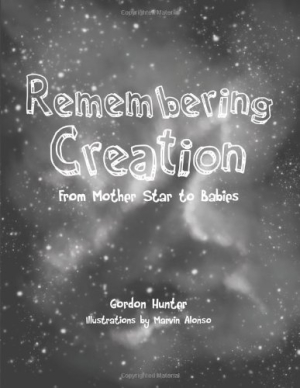Remembering Creation
From Mother Star to Babies
These scientific tales, written in a bedtime story style, beg to be read over again as they provoke curiosity and improve understanding of the universe.
The story of the creation of life can be seen as poetic or strictly the domain of science, depending on the teller. In the children’s book Remembering Creation: From Mother Star to Babies, Gordon Hunter, a science teacher and professor, has blended thorough scientific explanations with a light, poetic sensibility.
The award-winning biology professor, who has also served as a public school science teacher and consultant, is well-suited to the task of explaining creation to children.
The book begins in a way that seems meant to evoke a children’s bedtime story: “Once upon a time so long ago that nobody remembers—in fact, there was nobody to remember—there appeared in the Milky Way galaxy, our home in the universe, a huge shapeless cloud, so large that it could have surrounded our entire solar system and much more.” Hunter quickly transitions into hard-science mode with his next sentence, however: “The cloud was dusty and full of hydrogen atoms.”
Key words are boldfaced throughout the text, and as the book continues, Hunter offers an account of how the basic elements were created, and how the sun and planets of our solar system were born. Eventually, readers arrive at the beginning of life. Hunter wants kids to understand the full story, so instead of skipping straight to humans, he explains the beginning of cells, bacteria, and multicellular organisms.
Chapters are short but dense at times, and some children could have difficulty following the language and concepts, which include nuclear energy, gravity, solar wind, and more. Hunter provides clear definitions, but adults will likely need to stop and provide additional clarification, simply because there’s so much information being discussed.
Illustrations range from technical in nature (graphic representations of hydrogen atoms combining to form helium, bacteria dividing, or other processes) to the more typical fare of a children’s book, with pedestrian pictures of a smiling “mother star” or our sun “blowing” the solar wind out into space. There are also black-and-white photos of craters, asteroids entering the atmosphere, and heat venting from Earth’s crust.
Hunter begins each chapter with some variation of the “once upon a time” introduction, which quickly gets monotonous, and these attempts to soften the heavy scientific content might not hit the mark with readers. But as a beginner’s science book, Hunter’s text succeeds.
Remembering Creation is a unique book that a child could reread over time, gleaning a little better understanding with each effort. While it might get a bit too technical at times for some younger readers, there aren’t many authors of children’s books who would even attempt to cover so much ground in so few pages, let alone do it as well.
Reviewed by
Peter Dabbene
Disclosure: This article is not an endorsement, but a review. The publisher of this book provided free copies of the book and paid a small fee to have their book reviewed by a professional reviewer. Foreword Reviews and Clarion Reviews make no guarantee that the publisher will receive a positive review. Foreword Magazine, Inc. is disclosing this in accordance with the Federal Trade Commission’s 16 CFR, Part 255.

